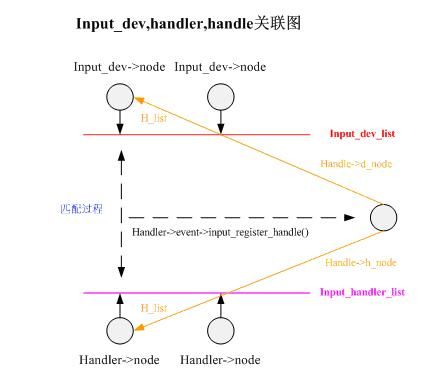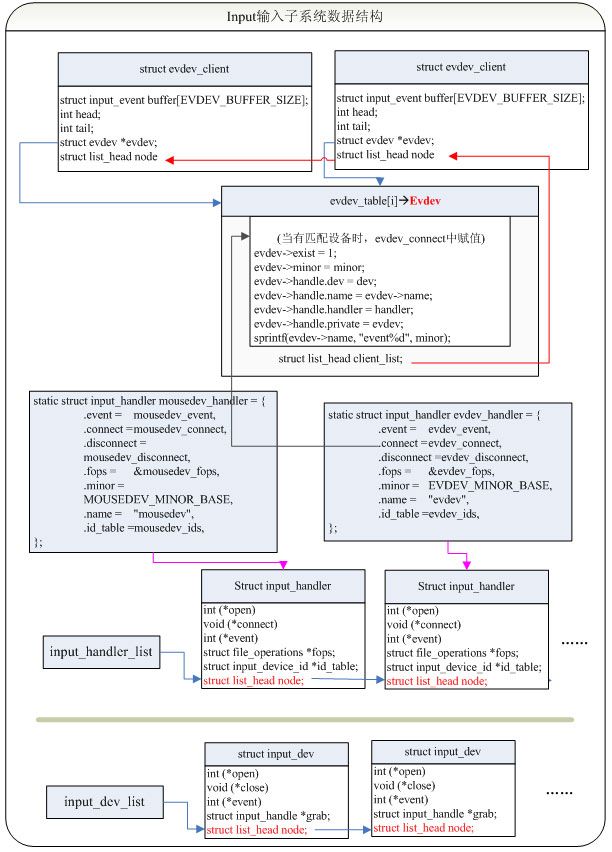linux驱动开发——Input驱动
什么是INPUT
Input子系统处理输入事务,任何输入设备的驱动程序都可以通过Input输入子系统提供的接口注册到内核,利用子系统提供的功能来与用户空间交互。输入设备一般包括键盘,鼠标,触摸屏等,在内核中都是以输入设备出现的。下面分析input输入子系统的结构,以及功能实现。
linux中input系统主设备号是13
次设备号:
0-31 joystick(游戏杆)
32-62 mouse(鼠标)
63 mice(鼠标)
64-95 事件(Event)设备
1. Input子系统是分层结构的,总共分为三层: 硬件驱动层,子系统核心层,事件处理层。
(1)其中硬件驱动层负责操作具体的硬件设备,这层的代码是针对具体的驱动程序的,需要驱动程序的作者来编写。
(2)子系统核心层是链接其他两个层之间的纽带与桥梁,向下提供驱动层的接口,向上提供事件处理层的接口。
(3)事件处理层负责与用户程序打交道,将硬件驱动层传来的事件报告给用户程序。
2.Input子系统的三个重要结构体:
input_dev 是硬件驱动层,代表一个input设备
input_handler 是事件处理层,代表一个事件处理器
input_handle 个人认为属于核心层,代表一个配对的input设备与input事件处理器
- struct input_handle {
- void *private; //每个配对的事件处理器都会分配一个对应的设备结构,如evdev事件处理器的evdev结构,注意这个结构与设备驱动层的input_dev不同,初始化handle时,保存到这里。
- int open; //打开标志,每个input_handle 打开后才能操作,这个一般通过事件处理器的open方法间接设置
- const char *name;
- struct input_dev *dev; //关联的input_dev结构
- struct input_handler *handler; //关联的input_handler结构
- struct list_head d_node; //input_handle通过d_node连接到了input_dev上的h_list链表上
- struct list_head h_node; //input_handle通过h_node连接到了input_handler的h_list链表上
- };
struct input_handle {
void *private; //每个配对的事件处理器都会分配一个对应的设备结构,如evdev事件处理器的evdev结构,注意这个结构与设备驱动层的input_dev不同,初始化handle时,保存到这里。
int open; //打开标志,每个input_handle 打开后才能操作,这个一般通过事件处理器的open方法间接设置
const char *name;
struct input_dev *dev; //关联的input_dev结构
struct input_handler *handler; //关联的input_handler结构
struct list_head d_node; //input_handle通过d_node连接到了input_dev上的h_list链表上
struct list_head h_node; //input_handle通过h_node连接到了input_handler的h_list链表上
};
- struct input_handler {
- void *private;
- void (*event)(struct input_handle *handle, unsigned int type, unsigned int code, int value);
- int (*connect)(struct input_handler *handler, struct input_dev *dev, const struct input_device_id *id);
- void (*disconnect)(struct input_handle *handle);
- void (*start)(struct input_handle *handle);
- const struct file_operations *fops;
- int minor;
- const char *name;
- const struct input_device_id *id_table;
- const struct input_device_id *blacklist;
- struct list_head h_list;
- struct list_head node;
- };
struct input_handler {
void *private;
void (*event)(struct input_handle *handle, unsigned int type, unsigned int code, int value);
int (*connect)(struct input_handler *handler, struct input_dev *dev, const struct input_device_id *id);
void (*disconnect)(struct input_handle *handle);
void (*start)(struct input_handle *handle);
const struct file_operations *fops;
int minor;
const char *name;
const struct input_device_id *id_table;
const struct input_device_id *blacklist;
struct list_head h_list;
struct list_head node;
};
- struct input_dev {
- void *private;
- const char *name;
- const char *phys;
- const char *uniq;
- struct input_id id;
- <SPAN style="WHITE-SPACE: pre"> </SPAN>........
- int (*open)(struct input_dev *dev);
- void (*close)(struct input_dev *dev);
- int (*flush)(struct input_dev *dev, struct file *file);
- int (*event)(struct input_dev *dev, unsigned int type, unsigned int code, int value);
- struct class_device cdev;
- union { /* temporarily so while we switching to struct device */
- struct device *parent;
- } dev;
- struct list_head h_list;
- struct list_head node;
struct input_dev {
void *private;
const char *name;
const char *phys;
const char *uniq;
struct input_id id; ........
int (*open)(struct input_dev *dev);
void (*close)(struct input_dev *dev);
int (*flush)(struct input_dev *dev, struct file *file);
int (*event)(struct input_dev *dev, unsigned int type, unsigned int code, int value);
struct class_device cdev;
union { /* temporarily so while we switching to struct device */
struct device *parent;
} dev;
struct list_head h_list;
struct list_head node;
- }
}
- 在内核中,input_dev 表示一个 input设备;input_handler 来表示input设备的 interface。 所有的input_dev 用双向链表 input_dev_list 连起来。
- 在调用 int input_register_device(struct input_dev *dev) 的时候,会将新的 input_dev 加入到这个链表中。所有的input_handler 用双向链表 input_handler_list 连起来。
- 在调用 int input_register_handler(struct input_handler *handler) 的时候,会将新的 input_handler 加入到这个链表中。每 个input_dev 和 input_handler 是要关联上才能工作的,在注册 input_dev 或者 input_handler的时候,就遍历上面的列表,找到相匹配的,然后调用 input_handler 的 connect函数来将它们联系到一起。
- 通常在input_handler 的 connect函数中,就会创建 input_handle, input_handle就是负责将 input_dev 和input_handler 联系在一起的.
输入事件
各层之间通信的基本单位就是事件,任何一个输入设备的动作都可以抽象成一种事件,如键盘的按下,触摸屏的按下,鼠标的移动等。事件有三种属性:类型(type),编码(code),值(value),Input子系统支持的所有事件都定义在input.h中,包括所有支持的类型,所属类型支持的编码等。事件传送的方向是 硬件驱动层-->子系统核心-->事件处理层-->用户空间
设备有着自己特殊的按键键码,我需要将一些标准的按键,比如0-9,X-Z等模拟成标准按键,比如KEY_0,KEY-Z等,所以需要用到按键模拟,具体 方法就是操作/dev/input/event1文件,向它写入个input_event结构体就可以模拟按键的输入了。
linux/input.h中有定义,这个文件还定义了标准按键的编码等
struct input_event {
struct timeval time; //按键时间
__u16 type; //类型,在下面有定义
__u16 code; //要模拟成什么按键
__s32 value;//是按下还是释放
};
code:
事件的代码.如果事件的类型代码是EV_KEY,该代码code为设备键盘代码.代码植0~127为键盘上的按键代码,0x110~0x116 为鼠标上按键代码,其中0x110(BTN_ LEFT)为鼠标左键,0x111(BTN_RIGHT)为鼠标右键,0x112(BTN_ MIDDLE)为鼠标中键.其它代码含义请参看include/linux/input.h文件. 如果事件的类型代码是EV_REL,code值表示轨迹的类型.如指示鼠标的X轴方向REL_X(代码为0x00),指示鼠标的Y轴方向REL_Y(代码 为0x01),指示鼠标中轮子方向REL_WHEEL(代码为0x08).
value:
事件的值.如果事件的类型代码是EV_KEY,当按键按下时值为1,松开时值为0;如果事件的类型代码是EV_ REL,value的正数值和负数值分别代表两个不同方向的值.
type:
/*
* Event types功能实现
*/
#define EV_SYN0x00 // 表示设备支持所有的事件
#define EV_KEY 0x01 // 键盘或者按键,表示一个键码
#define EV_REL 0x02 // 鼠标设备,表示一个相对的光标位置结果(相对坐标)
#define EV_ABS 0x03 // 手写板产生的值,其是一个绝对整数值
#define EV_MSC 0x04 // 其他类型
#define EV_SW 0x05 //
#define EV_LED 0x11 // LED灯设备
#define EV_SND 0x12 // 输入声音
#define EV_REP 0x14 // 允许重复按键类型
#define EV_FF 0x15 //
#define EV_PWR 0x16 // 电源管理事件
#define EV_FF_STATUS0x17
#define EV_MAX 0x1f
有哪些API
分配/释放一个输入设备:
struct input_dev *input_allocate_device(void);
void input_free_device(struct input_dev *dev);
注册/注销输入设备:
int __must_check input_register_device(struct input_dev *);
void input_unregister_device(struct input_dev *);
报告输入事件:
void input_event(struct input_dev *dev, unsigned int type, unsigned int code, int value);/* 报告指定type、code的输入事件 */
void input_report_key(struct input_dev *dev, unsigned int code, int value);/* 报告键值 */
void input_report_rel(struct input_dev *dev, unsigned int code, int value);/* 报告相对坐标 */
void input_report_abs(struct input_dev *dev, unsigned int code, int value);/* 报告绝对坐标 */
void input_sync(struct input_dev *dev);/* 报告同步事件 */
Input驱动编写步骤
1.分配一个输入设备;Set_bit(EV_KEY,button_dev.evbit)
Struct input_dev中有两个成员,一个是evbit;一个是keybit.分别用来表示设备所支持的事件类型和按键类型。

